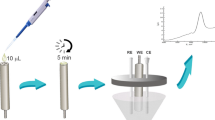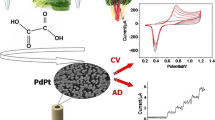Abstract
Salicylic acid (SA) is used as a preservative in food and a biocide in some consumer products. However, in some countries its use is prohibited. The main problem in the electroanalytical determination of SA is the formation of a passive film during the electro-oxidation of SA. To alleviate the passivation during SA measurement, the experiment was conducted by screen-printed carbon electrode (SPCE). While, differential pulse voltammetry (DPV) was essential for oxidation process to provide better sensitivity. Under conditions of optimized pH and electrolyte concentration, we have calibrated SA in the range of 0.001–0.2 mM, with and LOD of 1.6 μM. The relative standard deviation of the sensor responses to 40 µM and 100 µM SA (n = 20) was < 3%. SA recoveries in samples such as pickled green mustard, pickled bamboo shoots, pickled mango, pickled lime, pickle ginger and apple juice were found to be in the range of 84–113%.
Graphic Abstract






Similar content being viewed by others
References
Compant S, Duffy B, Nowak J, Clement C, Barka EA. Use of plant growth-promoting bacteria for biocontrol of plant diseases: principles, mechanisms of action, and future prospects. Appl Environ Microbiol. 2005;71(9):4951–9. https://doi.org/10.1128/AEM.71.9.4951-4959.2005.
FoodProtectionDivision. Prohibited Substance in Food Regulation (Thai). Food Law and Regulation. Bangkok, Thailand: Food and Drug Administration, Ministry of Public Health Thailand; 1993. p. 1–2.
Trinder P. Rapid determination of salicylate in biological fluids. Biochem J. 1954;57(2):301–3. https://doi.org/10.1042/bj0570301.
Karim MM, Lee HS, Kim YS, Bae HS, Lee SH. Analysis of salicylic acid based on the fluorescence enhancement of the As(III)–salicylic acid system. Anal Chim Acta. 2006;576(1):136–9. https://doi.org/10.1016/j.aca.2006.02.004.
McMahon GP, O’Connor SJ, Fitzgerald DJ, le Roy S, Kelly MT. Determination of aspirin and salicylic acid in transdermal perfusates. J Chromatogr B Biomed Sci Appl. 1998;707(1–2):322–7. https://doi.org/10.1016/S0378-4347(97)00580-X.
Chocholouš P, Holík P, Šatínský D, Solich P. A novel application of Onyx™ monolithic column for simultaneous determination of salicylic acid and triamcinolone acetonide by sequential injection chromatography. Talanta. 2007;72(2):854–8. https://doi.org/10.1016/j.talanta.2006.12.009.
Tseng P-J, Wang C-Y, Huang T-Y, Chuang Y-Y, Fu S-F, Lin Y-W. A facile colorimetric assay for determination of salicylic acid in tobacco leaves using titanium dioxide nanoparticles. Anal Methods. 2014;6(6):1759–65. https://doi.org/10.1039/C3AY42209G.
Liu JW, Deng DY, Yu Y, Liu FF, Lin BX, Cao YJ, et al. In situ detection of salicylic acid binding sites in plant tissues. Luminescence. 2015;30(1):18–25. https://doi.org/10.1002/bio.2682.
Scotter MJ, Roberts DPT, Wilson LA, Howard FAC, Davis J, Mansell N. Free salicylic acid and acetyl salicylic acid content of foods using gas chromatography–mass spectrometry. Food Chem. 2007;105(1):273–9. https://doi.org/10.1016/j.foodchem.2007.03.007.
Aresta A, Zambonin C. Simultaneous determination of salicylic, 3-methyl salicylic, 4-methyl salicylic, acetylsalicylic and benzoic acids in fruit, vegetables and derived beverages by SPME–LC–UV/DAD. J Pharm Biomed Anal. 2016;121:63–8. https://doi.org/10.1016/j.jpba.2015.12.016.
Sharma HSS, Carmichael E, McCall D. Fabrication of SERS substrate for the detection of rhodamine 6G, glyphosate, melamine and salicylic acid. Vib Spectrosc. 2016;83:159–69. https://doi.org/10.1016/j.vibspec.2016.01.011.
do Prado TM, Machado SAS. Spectroelectrochemical study of salicylate in alkaline medium. J Solid State Electrochem. 2016;20:2569–74. https://doi.org/10.1007/s10008-015-3106-2.
Kirchner C, Javier AM, Susha AS, Rogach AL, Kreft O, Sukhorukov GB, et al. Cytotoxicity of nanoparticle-loaded polymer capsules. Talanta. 2005;67(3):486–91. https://doi.org/10.1016/j.talanta.2005.06.042.
Torriero AAJ, Luco JM, Sereno L, Raba J. Voltammetric determination of salicylic acid in pharmaceuticals formulations of acetylsalicylic acid. Talanta. 2004;62(2):247–54. https://doi.org/10.1016/j.talanta.2003.07.005.
Zhu Y, Guan X, Ji H. Electrochemical solid phase micro-extraction and determination of salicylic acid from blood samples by cyclic voltammetry and differential pulse voltammetry. J Solid State Electrochem. 2009;13(9):1417–23. https://doi.org/10.1007/s10008-008-0707-z.
Park J, Eun C. Electrochemical behavior and determination of salicylic acid at carbon-fiber electrodes. Electrochim Acta. 2016;194:346–56. https://doi.org/10.1016/j.electacta.2016.02.103.
Rawlinson S, Mclister A, Kanyong P, Davis J. Rapid determination of salicylic acid at screen printed electrodes. Microchem J. 2018;137:71–7. https://doi.org/10.1016/j.microc.2017.09.019.
Vadivaambigai A, Senthilvasan PA, Kothurkar N, Rangarajan M. Graphene-oxide-based electrochemical sensor for salicylic acid. Nanosci Nanotechnol Lett. 2015;7(2):140–6. https://doi.org/10.1166/nnl.2015.1909.
Ribeiro CD, Santos JGM, de Souza JR, Pereira-da-Silva MA, Paterno LG. Electrochemical oxidation of salicylic acid at ITO substrates modified with layer-by-layer films of carbon nanotubes and iron oxide nanoparticles. J Electroanal Chem. 2017;805:53–9. https://doi.org/10.1016/j.jelechem.2017.09.063.
Wang CL, Shen MJ, Ding YP, Zhao DS, Cui SQ, Li L. Facile preparation of multilayer ultrathin films based on eriochrome black T/NiAl-layered double hydroxide nanosheet, characterization and application in amperometric detection of salicylic acid. J Electroanal Chem. 2017;785:131–7. https://doi.org/10.1016/j.jelechem.2016.12.008.
Ribeiro CdL, Santos JGM, Souza JR, Paterno LG. Highly sensitive determination of salicylic acid in skin care product by means of carbon nanotube/iron oxide nanoparticle voltammetric sensors. J Solid State Electrochem. 2019;23(3):783–93. https://doi.org/10.1007/s10008-018-04189-y.
Sun L-J, Pan Z-Q, Xie J, Liu X-J, Sun F-T, Song F-M, et al. Electrocatalytic activity of salicylic acid on Au@Fe3O4 nanocomposites modified electrode and its detection in tomato leaves infected with Botrytis cinerea. J Electroanal Chem. 2013;706:127–32. https://doi.org/10.1016/j.jelechem.2013.07.038.
Reza Ganjali M, Nejad FG, Tajik S, Beitollahi H, Pourbasheer E, Larijanii B. Determination of salicylic acid by differential pulse voltammetry using ZnO/Al2O3 nanocomposite modified graphite screen printed electrode. Int J Electrochem Sci. 2017;12(11):9972–82. https://doi.org/10.20964/2017.11.49.
Cao XD, Zhu XT, He SD, Xu X, Ye YK, Gunasekaran S. Gold nanoparticle-doped three-dimensional reduced graphene hydrogel modified electrodes for amperometric determination of indole-3-acetic acid and salicylic acid. Nanoscale. 2019;11(21):10247–56. https://doi.org/10.1039/c9nr01309a.
Ai S, Wang Q, Li H, Jin L. Study on production of free hydroxyl radical and its reaction with salicylic acid at lead dioxide electrode. J Electroanal Chem. 2005;578(2):223–9. https://doi.org/10.1016/j.jelechem.2005.01.002.
Supalkova V, Petrek J, Havel L, Krizkova S, Petrlova J, Adam V, et al. Electrochemical sensors for detection of acetylsalicylic acid. Sensors (Basel). 2006;6(11):1483–97.
Enache TA, Fatibello-Filho O, Oliveira-Brett AM. Electrochemical behavior of triflusal, aspirin and their metabolites at glassy carbon and boron doped diamond electrodes. Comb Chem High Throughput Screen. 2010;13(7):569–77. https://doi.org/10.2174/1386207311004070569.
Petrek J, Havel L, Petrlova J, Adam V, Potesil D, Babula P, et al. Analysis of salicylic acid in willow barks and branches by an electrochemical method. Russ J Plant Physiol. 2007;54(4):553–8. https://doi.org/10.1134/S1021443707040188.
Skoog D, Holler F, Crouch S. Principles of instrumental analysis. Boston: Cengage Learning; 2007.
Boumya W, Laghrib F, Lahrich S, Farahi A, Achak M, Bakasse M, et al. Electrochemical behavior study of salicylic acid following azo dye formation with 2,4-dinitrophenylhydrazine: analytical evaluation. S Afr J Chem Eng. 2018;25:48–53. https://doi.org/10.1016/j.sajce.2018.01.002.
Luo ZS, Wu X, Xie Y, Chen C. Alleviation of chilling injury and browning of postharvest bamboo shoot by salicylic acid treatment. Food Chem. 2012;131(2):456–61. https://doi.org/10.1016/j.foodchem.2011.09.007.
AOAC International. Official methods of analysis of AOAC international. 17th ed. 2000.
Zavar MHA, Heydari S, Rounaghi GH. Electrochemical determination of salicylic acid at a new biosensor based on polypyrrole-banana tissue composite. Arab J Sci Eng. 2013;38(1):29–36. https://doi.org/10.1007/s13369-012-0411-2.
Acknowledgements
We gratefully acknowledge the financial support provided by Agricultural Research Development Agency (Grant no. CRP5507010820), and the King Mongkut’s University of Technology Thonburi through the “KMUTT 55th Anniversary Commemorative Fund” (Grant number 60000331).
Author information
Authors and Affiliations
Corresponding authors
Electronic supplementary material
Below is the link to the electronic supplementary material.
About this article
Cite this article
Detpisuttitham, W., Phanthong, C., Ngamchana, S. et al. Electrochemical Detection of Salicylic Acid in Pickled Fruit/Vegetable and Juice. J. Anal. Test. 4, 291–297 (2020). https://doi.org/10.1007/s41664-020-00127-y
Received:
Accepted:
Published:
Issue Date:
DOI: https://doi.org/10.1007/s41664-020-00127-y




